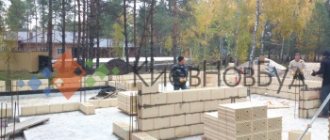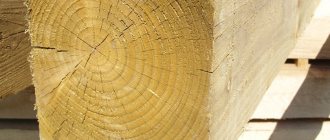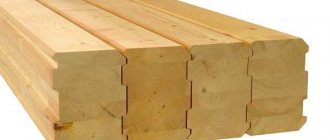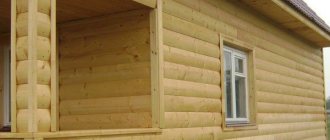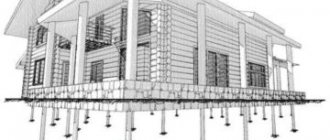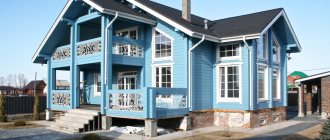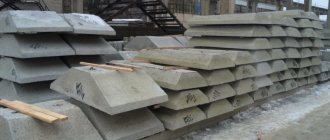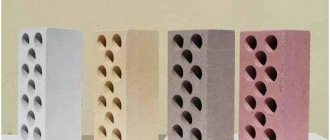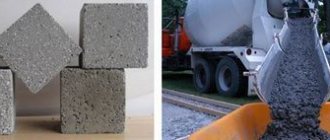Foam concrete blocks today successfully compete with bricks in low-rise and household construction.
They are obtained by mixing cement, sand (ash) and water with a foaming agent, resulting in cellular concrete.
If for a brick weight is a given characteristic, then for a foam block it is a system-forming one. It determines the density, structure, composition, purpose, and other properties and characteristics of the product.
The presence of a cement binder in cellular concrete ensures its strengthening over time up to four times over 35 years of service.
Concept
Unlike bricks, the load of which is constant, for foam concrete stones it will be different for products of the same size, depending on the brand and moisture content of the surrounding air. This is due to the fact that they have a porous structure and, depending on the ratio of voids and partitions in the material, their density and degree of water absorption changes.
So, the dry weight of wall blocks 60×30×20 cm, depending on the brand, will be as follows:
- D 300 – 11.7 kg;
- D 500 – 19.4 kg;
- D 700 – 27.2 kg;
- D 1000 – 39.6 kg, etc.
Taking into account the sorption moisture content of sand-based foam concrete, varying from 8 to 15% (GOST 25485-89), the minimum moisture in the material, grade D500, will be 1.55 kg (19.4 × 0.08). Then the total mass will be almost 21 kg (19.4 + 1.55).
Over time, under the influence of external conditions, the severity of foam concrete can increase. Therefore, there are special tables that allow you to monitor how it changes depending on humidity.
What do the indicators depend on?
Their mass depends on the composition, i.e. whether sand is used for mixing, ash or some other filler. Next is the brand, which is determined by the density, and dimensions (L × W × H). Finally, this is sorption humidity, which depends on the porosity of the material and air moisture.
Unlike bricks with a constant load for given sizes, these products of the same dimensions have different weights, for example,
a partition 60x10x30 cm, depending on the brand, weighs:
- D 300 – 5.8 kg,
- D 600 – 11.7 kg,
- D 900 – 17.8 kg, etc.
The sorption humidity of this product, as already noted, varies from 8 to 15%.
That is, the weight value of a product made from it, for example, under the D600 brand, will vary from 12.6 (11.7 × 1.08) to 13.5 (11.7 × 1.15) kg.
So, the load of foam concrete masses depends on:
- adding sand or ash to the batch;
- units of mass;
- size and sorption dampness.
According to GOST 25485-89, the sorption moisture content of foam concrete when manufactured using thermal power plant ash used as a filler can reach 22%.
Material weight range
It is important at any stage:
- design (for example, determining the load on the foundation);
- transportation;
- loading and unloading operations, masonry, etc.
The dry weight of a standard stone 60x30x20 cm varies from 10.8 to 43.2 kg , depending on the density (D300-D1200). The total mass, taking into account the level of moisture absorption, will range from 11.7 (10.8 × 1.08) to 49.7 (43.2 × 1.15) kg.
The kilogram of 1 m3 of foam concrete blocks does not depend on the size of a single product and is determined by the density of foam concrete, i.e. it is numerically equal to its brand. So, the mass of this stone with the D800 brand will be equal to 800 kg.
When using cutting technology for the production of blocks, it is possible to produce them up to 180 × 60 × 60 cm in size. The gravity force of such a D800 product will be 518.4 kg (1.8 × 0.6 × 0.6 × 800) .
Why can foam blocks of the same size differ in weight?
Foam blocks of the same size can weigh differently. It's all about density, which changes depending on the proportions of cement, water, sand or ash. The foam concrete block mainly consists of these elements.
Density is indicated by marking D and numbers indicating how much 1 cube of this foam concrete weighs.
Let me explain. Let's say the brand is D600. This means that 1 cubic meter of foam concrete from which the building block is made is equal to 600 kg. Accordingly, 1 cubic meter of foam blocks of this brand weighs 600 kg.
The importance of values when building walls
Information about their weight is relevant for anyone who is going to engage in new construction, repair and construction work, redevelopment or restoration using this material.
Knowing the mass of porous concrete before the start of construction work allows you to select the type of foundation you need , having previously calculated the load on it, solve logistics, organize loading and unloading operations and carry out installation.
Thus, if you do not know the weight of these materials when laying enclosing and separating structures, it may turn out that the bearing capacity of the selected foundation is not designed for this load and it will begin to collapse, which can lead to the complete unsuitability of the structure being built for its intended purpose.
Foam concrete stones, the density of which varies from 300 to 1200 kg/m³, are lightweight wall materials, since the density of ceramic brick is 1100-2000 kg/m³, silicate brick – 1100-1600 kg/m³, expanded clay concrete – 900-1850 kg /m³, etc.
The influence of mass on the choice of foundation type
The total load of a building under construction on the foundation is the sum of:
- roofing load;
- walls;
- items in the house;
- snow on the roof, etc.
Since these products are primarily used for wall construction, only this load component will be considered.
Let the total length of the external fences be equal to 36 linear meters with a thickness of 0.3 m, the internal ones - 24 linear meters and 0.12 m. The ceiling height is taken to be 2.7 m. We calculate the volume of the external walls: 36 × 2.7 × 0.3 = 29.2 m3. Volume of internal partitions: 24×2.7×0.12 = 7.8 m3.
For external walls, products of 60×30×20 cm brand D700 are suitable, for partitions – 60×12×20 cm D300. For the construction of external walls you will need 812 (29.2: 0.036) pieces, for partitions - 325 (7.8: 0.024).
Load on the foundation from external walls – 20440 (29.2×700) kg, from internal partitions – 2340 (7.8×300) kg. The total load from the named parts of the building is 22780 (20440+2340) kg.
By summing this load with the others, you can calculate the total impact on the foundation and use it to determine the required type, width and depth. One thing is certain: the width of the base cannot be less than 30 cm.
Considering the porous structure of the foam concrete material, the waterproofing between the wall and the foundation should be reliable and durable.
How to calculate how much a foam concrete block weighs?
If the number of blocks (N) in 1 m3 and the brand (D) are known, then the kilogram of one block is easy to find. Enough D: N = m – weight 1 pc. foam concrete block. But when N is unknown, then it is necessary to operate with dimensions (L × W × H) and brand D.
The sequence for calculating the m block is as follows:
- Stone volume: W = L × W × H.
- Density of the material ρ according to D, (if D400, then ρ = 400 kg/m3).
- The gravity of one dry stone is m = ρ × W.
- Load of absorbed moisture b = m × % humidity.
- Overall severity mtot. = m + b.
For stone size 600x300x200
You should use the above dependencies:
- Determination of volume W = 0.6 × 0.3 × 0.2 = 0.036 m3.
- According to grade D (let D900) the density of the material is ρ = 900 kg/m3.
- Dry load m = 900 × 0.036 = 32.4 kg.
- Sorptive moisture b = 32.4 × 0.08 = 2.6 kg.
- Total weight mtotal = 32.4 + 2.6 = 35 kg.
For 400x200x200
Repeating the calculation taking into account other sizes and brands:
- W = 0.4 × 0.2 × 0.2 = 0.016 m3.
- Brand D400, ρ = 400 kg/m3.
- m = 400 × 0.016 = 6.4 kg.
- b = 6.4 × 0.08 = 0.5 kg.
- mtotal = 6.4 + 0.5 = 6.9 kg.
If the weight calculation presents difficulties, then you need to contact the seller or manufacturer’s consultants with this question.
Share of sorption humidity
For foam concrete it depends on the components used and ranges from 8 to 15% for foam concrete based on quartz sand, and from 12 to 22% if the sand is replaced with fly ash from thermal power plants.
It should be taken into account that over time, due to external factors, this product becomes heavier. This must be taken into account when designing the base of the building - the foundation.
Special tables have been developed that make it possible to estimate the increase in gravity as a function of air humidity. The kilogram of wall components with an initial value of 10.8 to 43.2 kg can vary from 11.7 to 47.5 kg, respectively, when the relative air humidity is 75%.
What does value affect?
The mass of a foam block is not just a quantity, but an indicator of the density of the material, on which the technical characteristics, value of the material, and features of its application depend. The thoughtless material has more pores in its structure, so it exhibits salt of the earth properties of thermal insulation, but less bulk and strength, respectively.
Such blocks are suitable for thermal insulation purposes, but will not withstand heavy load-bearing loads. Blocks with greater weight have fewer pores in their structure, so their heat saving indicator is lower, but their density and irrefutability are higher, they can be used in the construction of walls.
The amazing weight of the block affects the cost and installation process in many ways. The less the material weighs, the easier it is to work with it. You can easily lay foam blocks with your own hands; you don’t need to bring in special equipment; it definitely reduces the cost of construction work.
The compactness of foam concrete is determined by its grade, which is designated by the letter D. Foam blocks of grades D300-500 are simply used for thermal insulation, D600-900 are considered structural and can be used in construction (at the same time, their insulating qualities are equally high). The material can withstand heat well and is not afraid of moderate mechanical influences; it is suitable for low-rise construction, except for insulation.
Blocks of grades D1000-1200 are the strongest and densest; they are used in the construction of multi-storey buildings with a mandatory layer of thermal insulation. The quality rating of the brand reflects the average compaction: for example, D300 foam concrete weighs 300 kg/m3 (average interpretation in a dry state).
In this case, the set is about standard characteristics and indicators that are established by GOSTs and must be fulfilled by manufacturers. But fortunately, the blocks are made in a handicraft way, is it possible with a change in technology in order to reduce the cost of the process, the values can be different. That is why it is serious to purchase foam blocks exclusively from trusted suppliers who have quality certificates and guarantee the ratio of the indicators indicated.
What can lead to errors in determining numbers?
Errors in determining their severity will primarily affect the choice of the type and size of the foundation.
If its load-bearing capacity is lower than the actual load, then problems will arise not only with the reliability of the building, but also with its further operation.
An overestimated load can lead to unnecessary logistics costs, since vehicles with a larger carrying capacity will be ordered or unnecessary flights will be ordered. When this indicator is underestimated, a reverse metamorphosis will occur.
There will be problems with loading and unloading operations and the construction of walls. This applies to both labor intensity and shortages or surpluses of wall products.
Advantages and disadvantages of foam concrete
For quite some time they have been arguing about which foam concrete to give preference to: autoclaved and non-autoclaved. Manufacturers of both types of products have their own arguments.
In fact, the gas silicate block is very close in characteristics to the foam concrete block, but each has its own negative qualities:
- Non-autoclave blocks have a high heat retention capacity. If compared with a material such as brick, then the thermal conductivity coefficient of foam blocks is reduced by approximately three times. The gas silicate block has a similar indicator.
- The mass of foam concrete blocks is small. Expanded clay concrete is more than two times heavier than foam concrete. Gas silicate blocks have a similar weight to foam blocks. This circumstance makes it possible to simplify loading and unloading operations with gas silicate and foam concrete blocks.
- They are easier to install and transport compared to traditional building materials. From such blocks, low-rise buildings can be erected without a heavy foundation, which can significantly reduce construction time.
- Taking into account the sufficient strength of foam blocks , the D900 brand can be used for the construction of load-bearing walls, however, no more than the third floor. When a reinforced concrete frame is installed, it is permissible to use foam blocks for the construction of multi-story buildings.
- Gas silicate blocks are somewhat stronger than foam blocks. Both types of blocks have excellent frost resistance. Their porous structure allows for plenty of space for water to accumulate and expand when it freezes. In this regard, if the walls freeze, they do not suffer damage either from the outer surface or inside the block.
- Both materials are highly fire resistant. Both gas silicate and foam concrete blocks can be exposed to open fire at very high temperatures for about four hours without significant damage. This is easy to check: you need to point the nozzle of a gas burner at a foam concrete wall and observe for several hours.
- Foam blocks have good environmental friendliness and biostability ; they do not rot or deteriorate over time.
- Buildings made from gas silicate blocks are less safe , since the autoclave promotes the foaming of tiny pieces of materials (aluminum, lime) and their entry into a chemical reaction, resulting in the formation of hydrogen compounds. In a later period, hydrogen is also released in small portions during the construction of block houses from gas silicate materials and their further operation.
- , synthetic or protein materials are used as a foaming agent In addition, this material has sealed pores, their structure is similar to foam plastic.
- Foam concrete is completely suitable for use in monolithic construction. Blocks are made from it directly at the construction site, for which a special installation is used. The compressor creates the required pressure and the resulting material is supplied through a hose to the location required for construction.
- Due to the specifics of monolithic construction , foam concrete can only have the functions of insulation or additional material.
For example, first a brick wall is made, the thickness of which is equal to half a brick. Next, from the inside or outside, stepping back a little, a plasterboard partition is installed. The resulting gap is filled with foam concrete to create a heat-insulating layer. This procedure does not require much time, and the cost is less than when installing traditional heat-insulating materials. - Foam concrete is processed very simply, it can be easily cut, drilled, and grooved. You don’t need any special tools for this; a minimum of physical effort is required. Foam blocks are transported very easily.
- Foam blocks have good moisture resistance due to hermetically sealed closed cells. Moisture cannot penetrate inside the block. If a block is placed in water, it will float. Whereas in gas silicate blocks, the internal channels pass through, so they are saturated with water in a short time.
- The cost of the material is quite low compared to the prices of other building materials. Due to the absence of the need to make a heavy, expensive foundation, the total cost of construction is significantly reduced.
